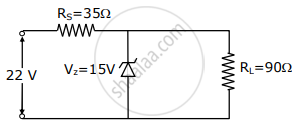Advertisements
Advertisements
Question
The amplifiers X, Y and Z are connected in series. If the voltage gains of X, Y and Z are 10, 20 and 30, respectively and the input signal is 1 mV peak value, then what is the output signal voltage (peak value)
- if dc supply voltage is 10V?
- if dc supply voltage is 5V?
Solution
Total voltage amplification is defined as the ratio of output signal voltage and input signal voltage.
According to the problem. voltage gain in X, vx = 10
Voltage gain in Y, vy = 20
Voltage gain in Z, vz = 30
ΔV1 = 1 mV = 10–3 V
And Total voltage amplification = vx × vy × vz
ΔV0 = vx × vy × vz × ΔV1
= 10 × 20 × 30 ×10–3 = 6V
- If DC supply voltage is 10 V, then output is 6 V, since the theoretical gain is equal to practical gain, i.e., the output can never be greater than 6 V.
- If DC supply voltage is 5 V, i.e., Vcc = 5 V. Then, the output peak will not exceed 5 V. Hence V0 = 5 V.
APPEARS IN
RELATED QUESTIONS
With the help of a neat circuit diagram, explain the working of a photodiode.
Using the necessary circuit diagrams, show how the V-I characteristics of a p-n junction are obtained in
Reverse biasing
How are these characteristics made use of in rectification?
The width of depletion region of p-n junction diode is _______.
(A) 0.5 nm to 1 nm
(B) 5 nm to 10 nm
(C) 50 nm to 500 nm
(D) 500 nm to 1000 nm
Describe, with the help of a circuit diagram, the working of a photodiode.
How does a light emitting diode (LED) work? Give two advantages of LED’s over the conventional incandescent lamps.
Draw the circuit arrangement for studying the V-I characteristics of a p-n junction diode in reverse bias. Plot the V-I characteristics in this case.
Answer the following question.
Explain the three processes involved in solar cell working.
In Figure, assuming the diodes to be ideal ______.

Briefly explain how emf is generated in a solar cell.
The value of power dissipated across the Zener diode (Vz = 15 V) connected in the circuit as shown in the figure is x × 10–1 watt. The value of x, to the nearest integer, is ______.

